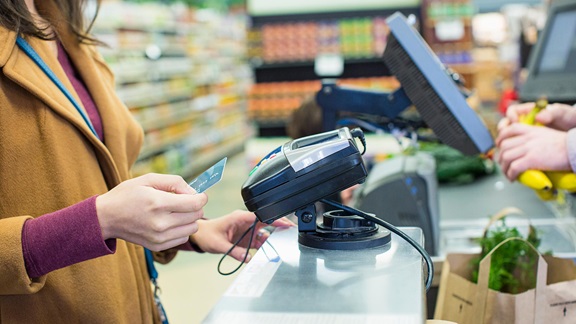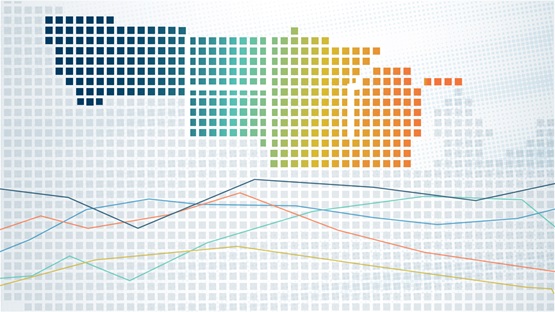A few cents at a time, the cost of a cup of coffee has been creeping upward a bit faster than it used to at Debra Jensen’s Black Hills Bagel Shop in Rapid City, S.D.
One reason is that the cost of paper cups has gone up, along with the cost of shipping them to her store.
Jensen said she’s used to seeing the price of a cup go up a cent a year, but recently the manufacturer increased the price by 3 cents. It’s a nice, sturdy cup that doesn’t require a paper sleeve to keep it rigid, and it’s recyclable, so she stuck with it. But, with the shop going through about 3,000 cups a week, the increase translates to an additional $4,700 a year.
A lot of other costs have gone up too, she said, listing wages, gasoline for the bagel delivery vehicle, and various supplies. Margins in the bakery business are thin, so she and her husband and co-owner Jack have had to raise prices more often than they used to.
Many other businesses in the area have had to do the same, she said. “The friends that I have in the retail business, small business, restaurant, café-type businesses, we absolutely have had to [raise prices] all summer long.”
Inflation had been creeping upward in the Midwest and throughout the nation since the early days of the pandemic, when it was close to zero, but has risen sharply since spring. That’s when inflation exceeded the Federal Reserve’s 2 percent target on its way to 4.3 percent in August. Many little price increases contributed to this situation, including higher prices for meals outside the home—coffee and bagels, for example—groceries, housing, used cars, and gasoline.
For consumers, it means they’re paying more, a lot more in some cases. For the Fed, the higher inflation rate largely reflects “transitory factors,” meaning the price increases in certain goods and services that have pushed inflation upward aren’t expected to continue year after year. In fact, inflation is starting to fall for some goods and services.
How inflation is measured
The best-known measure of inflation is the consumer price index (CPI), which shows changes in the prices of a basket of goods (and services) such as blocks of cheese, Netflix subscriptions, or glucose tests at the hospital. Household surveys determine the specific goods selected and how much weight they carry in the index. Surveyors then track the prices of these goods through store visits or by contacting service providers, such as hospitals and utilities. The CPI includes prices paid at the national and regional level, including the Midwest.
The producer price index (PPI) shows changes in the prices businesses receive for their products based on business surveys.
The CPI is used by businesses and government agencies to measure the cost-of-living adjustment for wages and benefits. It’s also widely cited by news media. The PPI is used for price adjustments in business contracts and as an economic indicator.
The Federal Reserve, however, relies heavily on the personal consumption expenditures (PCE) price index, which combines elements of the CPI and PPI in a way that the central bank considers to be a better reflection of economic reality. One reason is that the PCE index accounts for substitution. An example of substitution is when beef prices go up, consumers buy more chicken or pork. PCE inflation is usually a bit lower than CPI inflation for this reason.
Regardless of how they’re formulated, all of the indexes usually follow the same trend. And in the first half of the year, the monthly year-over-year inflation rates measured by those indexes shot upward and are still significantly elevated (Chart 1).
This article will mostly reference changes to the CPI because it’s the only index with up-to-date information specific to the Midwest, which includes all states in the Federal Reserve’s Ninth District except Montana. The focus will be on the three biggest components of the CPI and how they propelled inflation to levels not seen in decades. These are housing, which accounts for more than 40 percent of CPI; food and beverages, accounting for nearly 15 percent; and transportation, accounting for nearly 8 percent. Historically, the prices of food and energy, which contribute to housing and transportation prices, have been very volatile, meaning they increase and decrease relatively quickly.
Higher prices at the supermarket
For about five years before the pandemic, Midwestern food and beverage prices were very stable with year-over-year changes rarely exceeding 2 percent. But since the pandemic, increases have exceeded 2 percent in every month (Chart 2). In recent months, year-over-year inflation in this category has accelerated further.
Prices for restaurant meals and other food served outside the home have contributed a lot to this recent increase. This subcategory accounts for about 40 percent of the food and beverages category based on how it’s weighted in the CPI. As Jensen, the bagel shop owner, explained, a lot of this comes down to higher wages and supply chain disruptions.
Disruption is also a problem with groceries, which account for about half of food and beverages. The blame lies largely with inflated prices for meat, seafood, and eggs, which reached 7.2 percent in August and account for a fifth of the grocery subcategory. Fruits and vegetables, which accounts for another fifth, reached 3.9 percent.
Jamie Pfuhl, president of the Minnesota Grocers Association, compared the situation to an early morning highway accident that causes traffic to be backed up for hours afterward. “We grocers order products a long ways out to stock our shelves, and we watch the historic behavior of customers,” she said. By “a long ways,” she means several months.
When that behavior changes, it throws this well-oiled machine out of whack. For example, grocers know people do more baking during the holiday season, and mills know to produce more flour at that time of year. What they don’t expect is the baking mania that seized homebound office workers at the start of the pandemic, which led to a shortage of flour at the store.
Meat producers have also had to deal with many problems related to pandemic disruptions, from not being able to hire enough workers to having to change production lines to protect workers from COVID-19 to higher trucking costs, according to Pfuhl.
Midwestern consumers could take some comfort in their meat prices rising at a slightly slower rate than the national average. Many Midwestern states are major meat producers, and Minnesota has the advantage of being a meat-producing state next door to other meat-producing states. But aside from possibly lower trucking costs, that wouldn’t necessarily get grocers here better access. A nearby meat processor might have contracts with restaurant suppliers, not grocers.
“Unfortunately, at times the supply chain is less intuitive than we would think,” Pfuhl said.
The rising costs of driving
Transportation prices have long been subject to ups and downs because of volatile fuel prices, which account for a fifth of the transportation category as weighted by the CPI. But the recent price changes have been exceptionally volatile.
Gasoline prices fell by 42 percent at the start of the pandemic in April 2020 as public places were locked down and businesses sent office workers home. A year later, prices returned to pre-pandemic levels and then kept rising. A year-over-year comparison makes for some shocking inflation, but a comparison with 2019 levels shows that prices in April 2021 were basically the same as in April 2019. But prices didn’t stop rising. By August, they were 16 percent higher than two years ago (Chart 3), which is relatively normal as gasoline goes.
Tom Kloza, the global head of energy analysis at Oil Price Information Service, said this is in part a seasonal pattern with high demand from vacationers in the summer and the higher cost of refining summer blend. Gas station operators have also dealt with the same pandemic disruptions as other businesses, including high trucking costs, especially in Western states, and higher wages needed to attract workers.
Operators may also be trying to keep prices higher to make up for losses from 2020, he said.
The price of automobiles, especially used cars, has increased significantly, with used-car prices reaching levels of inflation never seen since current CPI methods of measurement began in 1978 (Chart 4). Changes in car prices make a big difference in transportation costs because they account for half of those costs as weighted by the CPI.
There are at least a couple of reasons why car prices have increased so much. First, demand for cars has been on the rise, in part because commuters fear catching COVID-19 on public transit. Second, a global shortage of computer chips used in modern cars has led to a decrease in production of new cars. This lack of new cars has also cut down on trade-ins, limiting the used-car market. A vehicle dealer in southern Minnesota told the Minneapolis Fed that the sales lot had 11 cars in September when it usually has more than 250 at this time of year.
Fortunately for consumers, used-car prices appear to be falling, and gasoline may soon follow.
Kloza said demand for travel usually shrinks going into winter and the cost of refining winter gasoline falls. It’ll take a while for gasoline prices to moderate just because gas station operators tend to raise prices faster than they lower them, he said. “I’m gonna use [Fed Chairman] Jerome Powell’s favorite word and say that, you know, the high numbers we saw this summer were transitory.”
Consumption of housing
Compared with food and transportation, housing costs have not inflated very dramatically. But housing is the single biggest CPI component, accounting for more than 40 percent of the index’s value. Food and beverages and transportation each account for 15 percent of CPI.
In the Midwest, housing costs were increasing faster than overall inflation before the pandemic. These increases slowed to less than 2 percent early in the pandemic but began rising rapidly this past spring (Chart 5).
Housing is an unusual category because it involves educated guesses by survey respondents. The CPI measures consumption, and here it’s measuring the value of shelter. Actual rent paid by tenants is not a matter of guesswork, but the value of shelter paid by homeowners is less clear. The government used to measure this using home prices, interest rates, and related indicators, but many considered this approach to be flawed for a variety of reasons. One is that it fails to distinguish between consumption of shelter and investment in real estate; what a homeowner pays for a house is both.
As a result, homeowners are now asked to estimate how much they could get if they rented out their home, which is meant to identify the consumption portion of their costs. This is called owner’s equivalent rent (OER), and it carries more weight than tenant rents. OER typically lags behind housing prices and is not subject to as much inflation.
Given the lag, the recent acceleration of housing costs in the CPI could be just the beginning. Home prices keep rising and don’t show any signs of moderating. According to the Zillow home value index, the price of a typical Midwestern home, defined as those in the 35th to 65th percentile, has been rising by double digits since winter and spring 2021, picking up the pace over the summer. A typical Minnesota home, for example, appreciated 10.3 percent year-over-year in May. As of August, the increase was 13.4 percent. The typical South Dakota home appreciated by 10.2 percent in June, reaching 11.9 percent in August.
A lot of this is because supply in the Midwest has not grown as quickly as demand. In the Ninth District, builders are still having a hard time hiring enough workers and purchasing building materials, according to a Minneapolis Fed survey in August. Project delays are rising, with one in five firms reporting a significant increase in delays.
An even larger source of higher housing costs was fuels and utilities (Chart 5), which began to see significant price hikes at the beginning of 2021 after several years of low inflation and deflation. The main driver of this has been natural gas, which experienced double-digit inflation starting in March and reaching 36.6 percent in August.
Midwestern states were hit hard, including those in the Ninth District. In the fall and spring, the price of natural gas delivered to residences in Minnesota increased by more than 10 percent year over year, according to the U.S. Energy Information Administration; winter data are missing. In North Dakota, spring brought price increases in the 10 percent to 30 percent range.
Natural gas utilities are regulated but often have market adjustment clauses that allow rates to go up when wholesale prices exceed a certain threshold. Some of the cost increases, based on news reports, are connected to the February 2021 storm that crippled natural gas production and distribution in Texas. But these higher prices aren’t expected to go away anytime soon, given rising demand and limited supplies caused by a lack of new production.
A lot of unknowns
Overall, Midwestern inflation as measured by the CPI has mellowed a bit with August year-over-year inflation lower than previous months though still elevated compared with August 2020.
The question for consumers is, How long will it be before inflation returns to normal?
Some of the index’s major components, such as transportation, have started to see a slowdown in price increases. But others, such as food and housing, remain on an upward trajectory. It’s not clear to many in those industries when that will change.
Jensen, the bagel shop owner, said she and her husband used to review costs about twice a year to see if they should increase prices for their customers. But since the start of the pandemic, she said, he’s constantly reviewing costs because they change all the time. “I know he told me a few days ago that we’re gonna have to raise prices again.”
Pfuhl, the grocery industry representative, said she doesn’t see a return to normality at least in the near future. Hiring will probably continue to be a challenge, she said. “With the ongoing uncertainty of COVID, we are still evolving in this pandemic and crisis.”
Tu-Uyen Tran is the senior writer in the Minneapolis Fed’s Public Affairs department. He specializes in deeply reported, data-driven articles. Before joining the Bank in 2018, Tu-Uyen was an editor and reporter in Fargo, Grand Forks, and Seattle.





